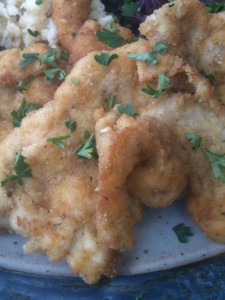Ingredients:

4 thin boneless pork chops or veal chops (we used chicken breasts instead)
1/2 c. oil (I use olive oil)
Flour
Parsley
butter
3/4 c. extra fine bread crumbs
2 eggs
salt & pepper
2 lemons
waxed paper
Heat the oil in a large skillet at medium high heat. Place each chop between two sheets of waxed paper and pound with the smooth side of a meat tenderizer until thin (1/4″ – 3/8″). Dip the meat into flour so that it is lightly covered. Beat the two eggs in a bowl that is wide enough to dip the meat into. Spread the bread crumbs onto a plate or flat surface.
Take each cutlet, season with salt and pepper and dip both sides of meat into eggs to coat. Then coat the entire cutlet with the bread crumbs. Place in hot oil and cook on both sides until golden brown. It only takes about 1-2 minutes per side. In a separate pan, melt 4 tbsp of butter. As a note, traditional recipes call for lard instead of butter. Once the cutlet is done frying, lightly fry it in the butter to give it the authentic German taste. Serve each cutlet with half a lemon on the side.




